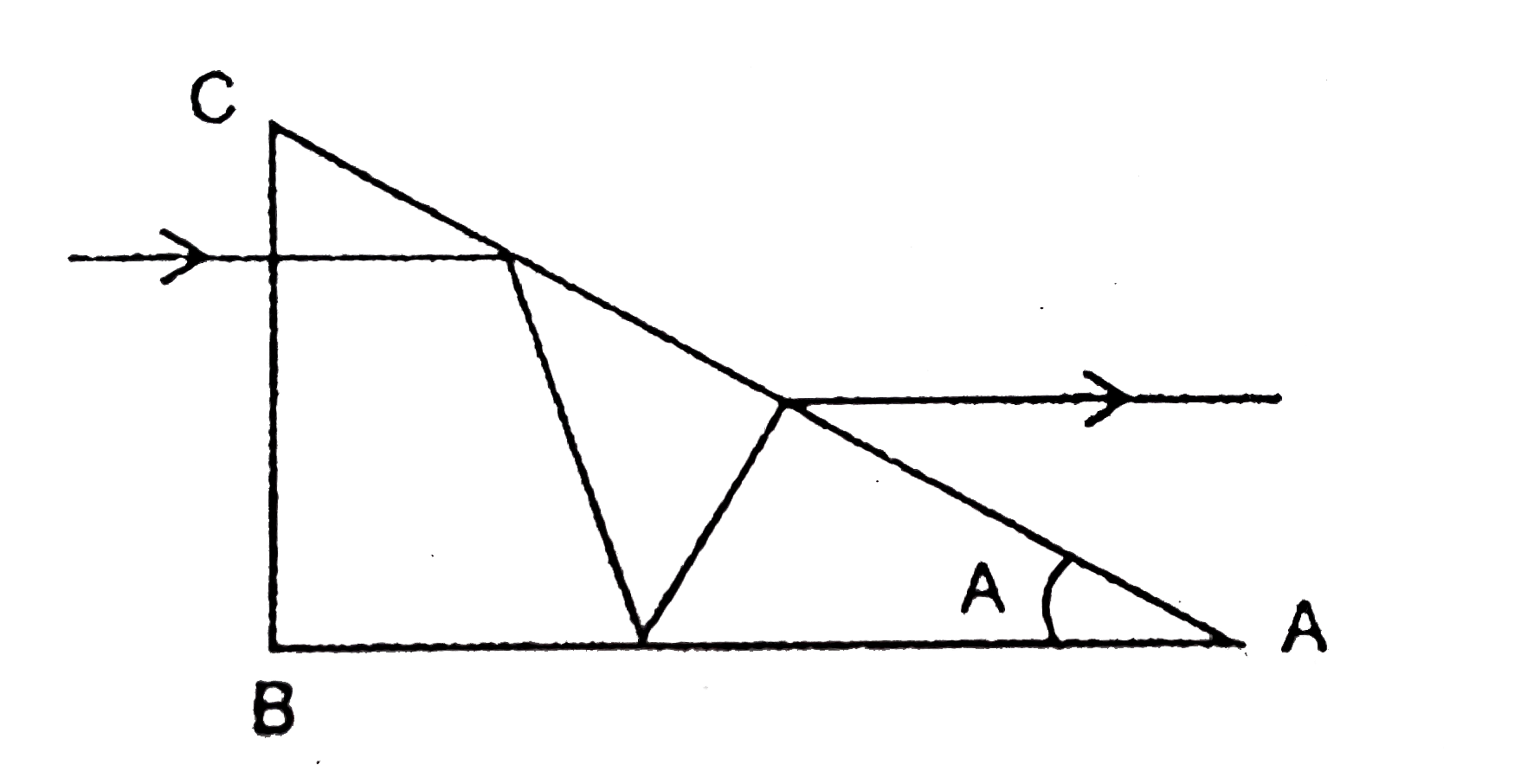A right prism is to be made by selecting a proper material and the angles A and B (B≤A) as shown in figure. It is desired that a ray of light incident normally on AB emerges parallel to the incident direction after two internal reflection.a. What should be the minimum refractive index μ for this to be possible? b. Forμ=53 is it possible to achieve this with the angle A equal to 60 degrees?Solution in Tamil

a. Consider the ray incident normally oN/AB ure. The asngle of reflectin at the surface AC is theta. It is clear from the ure that the angle of incidence ast th secon surface CB is 90∘−θ. The emergent ray will be paralel to the incidnet ray after two total inteN/Al refelection.The critical angle θc should be less than theta as well as 90∘−θ. Thus θc should be smaller than or equal to the smaler of θand90∘−θ,i.e,
theta_clemin(theta,90^@-theta)<br>Asmin(θ,90∘−θ)≤45∘,θc≤5∘
or sinθc≤1√2or1μ≤1√2
or μ≥1√2
Thus the refrctive index of the material of hte prism should be greater than or equal to √2. In this case teh gien ray can undrgo tow inteN/Al reflections for a suitable theta.
b. For μ=53 the critical angle θc is
sin−1(35)=37∘
As the ure suggests we consider the lightincident normally on the face AB. The angle of incidence θ on the surface AC is equal to θ=60∘. As this is larger than the cirtical angle 37∘, total internla reflection takes place here. The angle of incident at the surface CB is 90∘−θ=30∘. As this is less than teh critial ange, total interN/Al reflection does not take place at this surface.
Topper's Solved these Questions
- BOOK - HC VERMACHAPTER - GEOMETRICAL OPTICSEXERCISE - Question For short Answer19videos
GEOMETRICAL OPTICS
- BOOK - HC VERMACHAPTER - GEOMETRICAL OPTICSEXERCISE - Objective -118videos
GEOMETRICAL OPTICS
- BOOK - HC VERMACHAPTER - GEOMETRICAL OPTICSEXERCISE - Exercises79videos
GEOMETRICAL OPTICS
- BOOK - HC VERMACHAPTER - GAUSS LAWEXERCISE - Exercises24videos
GAUSS LAW
- BOOK - HC VERMACHAPTER - LIGHT WAVESEXERCISE - Exercises41videos
LIGHT WAVES
Similar Questions
Is the formula "Real depth/Apparent depth =μ. valid if viewed from a position quite away from the normal ?
07:01View SolutionA point source of light is placed in front of a plane mirror.
02:39View SolutionA concave mirror having a radius of curvature 40 cm is placed in front of an illuminated point source at a distance of 30 cm from it. Find the location of the image.
02:32View SolutionThe electric field in a region is given by →E=35E0→i+45E0→j with E0=2.0×103NC−1. Find the flux of this field through a recatngular surface of area 0.2m2 parallel to the y-z plane.
01:48View SolutionFind the range of frequency of light that is visible to an average human being (400nm<λ<700nm)
03:49View SolutionA right angled prism is to be made by selecting a proper material and the angles A and B (B≤A),asshown∈figure.Itisdesiredtˆarayoflight∈cntonthefaceABemer≥sparal≤l→the∈cntdirectionaftertwo∫ernalref≤ctions.<br><imga≤ocr_imageload∈g=lazysrc=https://d10lpgp6xz60nq.cloudfront.net/physics_images/DCP_V05_C31_S01_034_Q01.pngwh=80%mx-autosty≤=background:white;><br>(a)Wˆshod––betheminiμmretive∈dexnforthis→bepossib≤?<br>(b)Forn=5/3isitpossib≤→aχevethiswiththe∠Bequal→30 degrees?
03:08View SolutionA ray of light incident at an angle θ on a refracting face of a prism emerges from the other face normally. If the angle of the prism is 5∘ and the prism is made of a material of refractive index 1.5, the angle of incidence is.
View SolutionA ray of light falls normally on one face of a right angled prims of refracting angle A. It suffers two total internal reflections before coming out of prism parallel to incident ray as shown. Refractive index to prism material will be:
 04:11View Solution
04:11View SolutionLight rays from a source are incident on a glass prism of index of refraction μ and angle of prism α At near normal incidence, the angle of deviation of the emerging rays is
05:52View SolutionA ray is incident at an angle of incidence i on one surfcae of a small angle prism (with angle of prism A) and emerges normally from opposite surface. If refractive index of material of prism is mu then the angle of incidence is nearly equal to
04:07View SolutionA light ray is incident on one refraction face of a prism, of refractive angle A, at an angle of incidence, I and emerges from the opposite face, normally. If refractive index of the material of the prism be μ what will be the value of the angle of incidence?
05:17View SolutionA ray of light incident at an angle theta on a refracting face of a prism emerges from the other face normally. If the angle of prism is 5^(@) and the prism is made of a material of refractive index 1.5, the angle of incidence is
03:34View SolutionA ray of light incident at an angle θ on a refracting face of a prism emerges from the other face normally. If the angle of the prism is 5∘ and the prism is made of a material of refractive index 1.5, the angle of incidence is.
06:03View SolutionA ray of light incident at an angle θ on a refracting face of a prism emerges from the other face normally. If the angle of the prism is 5∘ and the prism is made of a material of refractive index 1.5, the angle of incidence is
02:23View SolutionA ray of light is incident at small angle I on the surface of prism of small angle A and emerges normally from the oppsite surface. If the refractive index of the material of the prism is mu, the angle of incidence is nearly equal to
03:22View SolutionA ray of light incident at an angle θ on a refracting face of a prism emerges from the other face normally. If the angle of the prism is 5∘ and the prism is made of a material of refractive index 1.5, the angle of incidence is.
01:48View Solution

